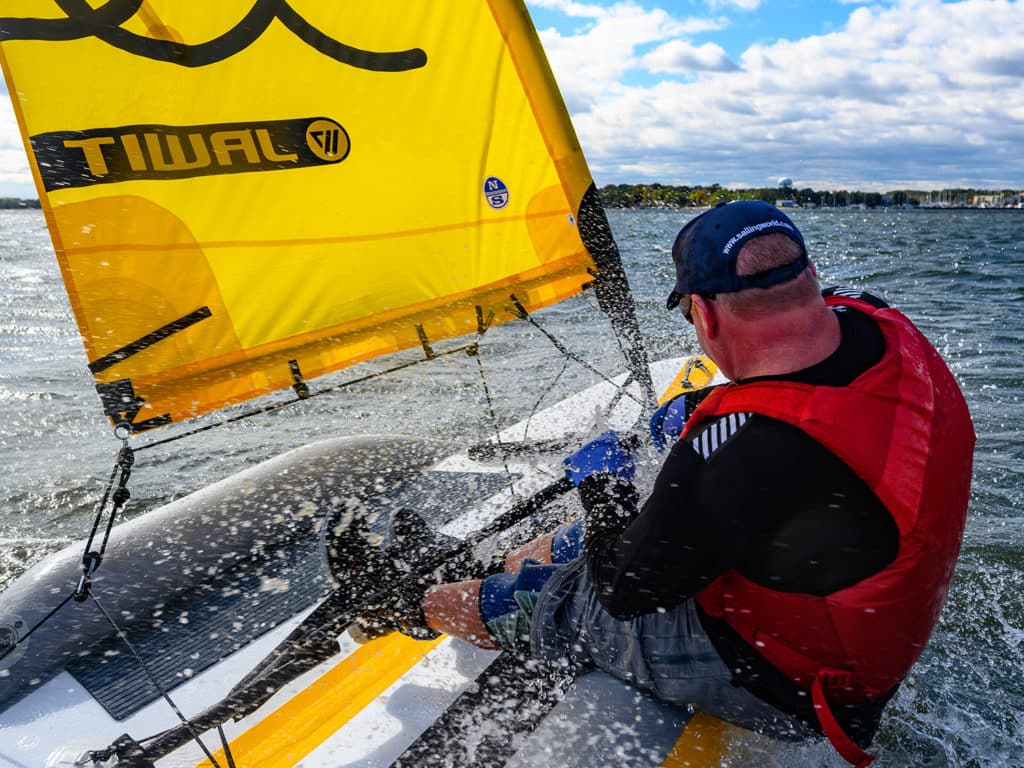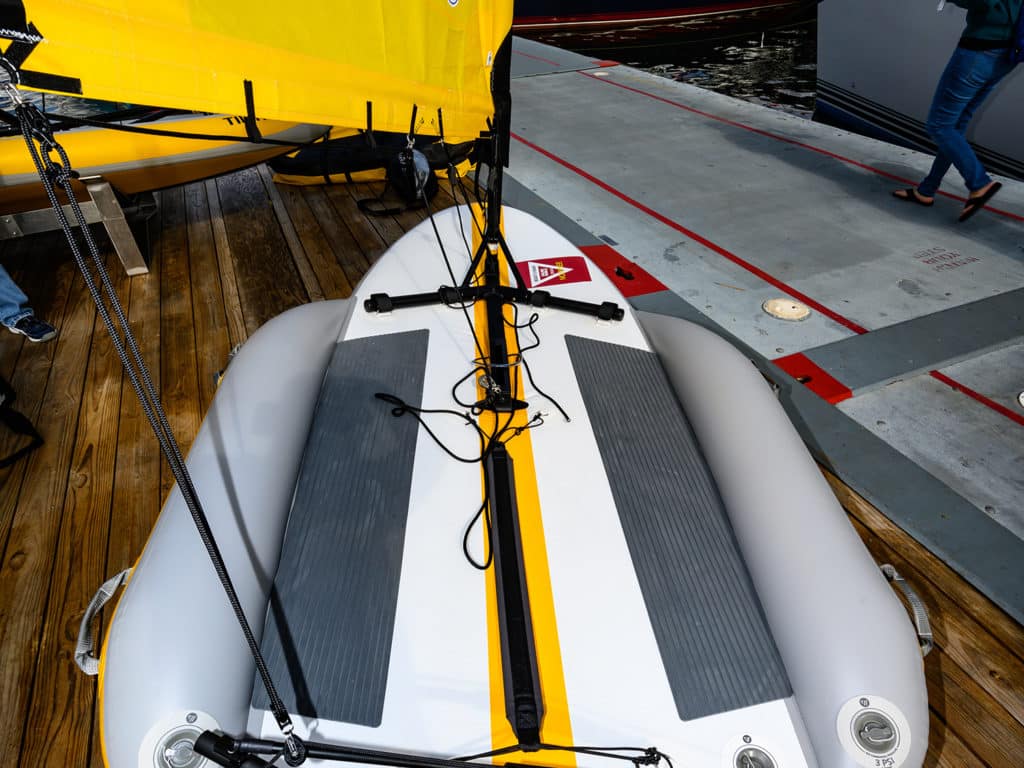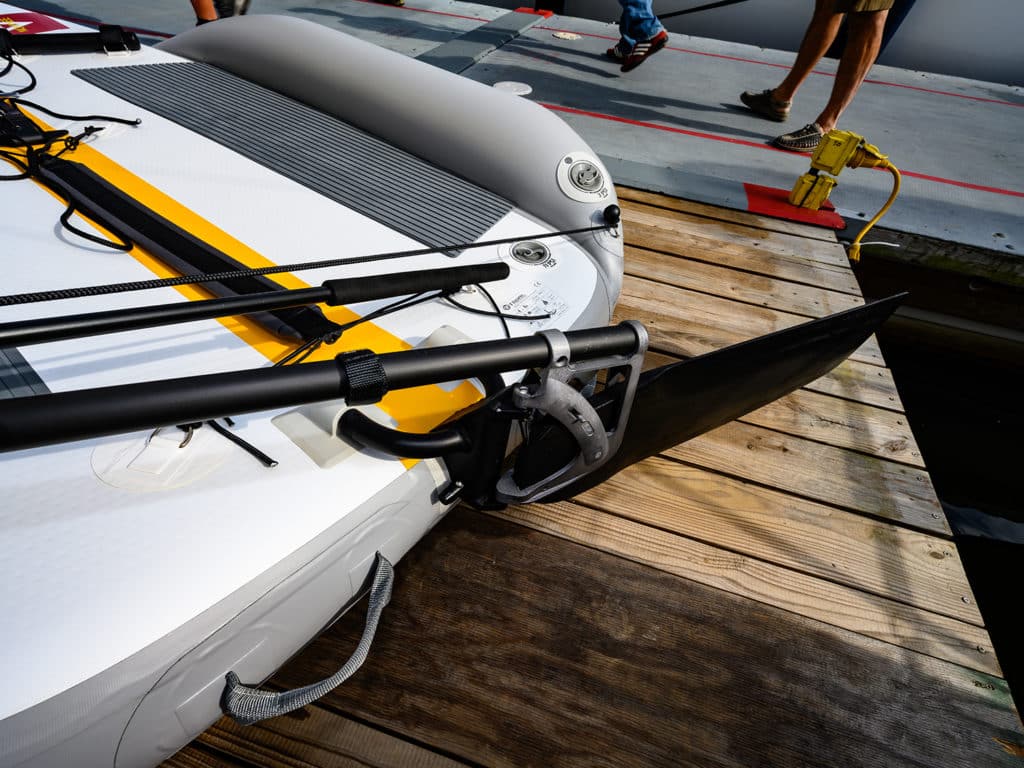
At A Glance
Price As Sailed: $4,800
Design Purpose: Freestyle sailing
Crew List: One or two
Allen and Stewart are like two oversize kids duking it out on the playground. Stewart, weighing in at a smidge over 200 pounds, is stretched out across the Tiwal 2’s nonskid decking, his feet dangling off the starboard float; his head pillowed by the port float. Allen is contorted over the top of the centerboard trunk, trying to get his Tiwal’s transom to break from the glassy surface. On starboard, he targets Stewart, who is trying to shake him in the prestart of the first-ever impromptu Tiwal 2 North American Challenge.
“Starboard!” Allen hollers.
“Hold your course!” Stewart retorts as he starts to bear away.
Allen can’t resist, and he too bears away as the two converge, plowing right into Stewart’s lap. The rubber boats simply bounce off each other and carry on up the course on opposite tacks.
“It’s Tiwal racing!” shouts its designer and energetic young visionary, Marion Excoffon, who is observing the comical two-boat slugfest from our Highfield RIB. “There are no rules. Only to have fun!”
Fun sailing is the way of the Tiwal tribe, an almost cult-like sailing community in Europe where hundreds of owners of these high-pressure, inflatable sailboats gather on lakes and Mediterranean beaches to play together.
Yes, they are “toy” boats, Excoffon says, but even as playthings, racing is irresistible whenever there’s more than one. It is also designed as a toy for a cruising boat that “allows you to sail and have an amazing moment around your boat while at anchor,” Excoffon says.

The Tiwal 2 is not to be confused with the larger Tiwal 3, a Boat of the Year finalist of the past, which has aluminum-bar racks for hiking. Customers asked for a smaller version that was also kinder to the gelcoat of their cruising boats and superyachts. The 9-foot, PVC-built Tiwal 2 weighs only 20 pounds. Add its marine-grade, coated plywood rudder and centerboard, ropes, hardware, five-piece carbon mast and bulletproof sail from North, and the whole enchilada is still only 60 pounds.
Portability is what has earned the Tiwal line of boats numerous innovation awards in Europe. When broken down to its bits, the entire craft fits into two duffle bags that are small enough to stuff into a lazarette or into the trunk of a Mini Cooper. Tiwal inflatables are standard equipment now in the toy boxes of superyachts, which Excoffon says is 20 percent of their market, where there can never be enough water toys.
“We’ve sold about 80 of them since this summer,” she says. “For less than $5,000, this boat is good for the whole family to share nice moments with your child, or to go have fun and play in good breeze. The boat is adaptable to different people, and adaptable to the wind.”
The judges agree with that much. They sail it first in glassy, drifting conditions, goof off and laugh their way to sunset. (Racing is ultimately abandoned, so there is no clear winner of the Tiwal Challenge.) With a gale in the forecast, however, they request a resail later in the week.
Allen takes the first spin, into frothy whitecaps whipped up by an opposing tide and wind at the entrance to the Severn River: “Downwind, in the 20-knot puffs and bigger waves, it was a little squirrelly, but once I got into flatter water and went power-reaching along, the thing was ripping and planing easily. Then I started playing with moving my weight and using my feet to push it around like a surfboard in the waves. It was so much fun. The rudder is nice and responsive; it turned on a dime.”
In one “angry puff of 30 knots” that comes along, he lets the sail luff, waits in “hang mode” and lets it pass. “The boat is quite buoyant, which is a nice safety element if a kid got caught out in too much breeze,” he says.

Tacking and jibing are easy, Allen adds, because of the buoyancy; and by vang sheeting and hardening the cunningham, he motors upwind. “I was surprised the bow wasn’t flexing all over the place, so whatever air pressure and stiffness they have going on there, it really works,” he says. “It was by far one of the most fun boats of the week. I’m a Tiwal fan—you can quote me on that.”
Stewart is a fan as well, but also claims to be 2 knots faster than Allen upwind because he’s heavier and able to use more of the sail. “I had a great time,” he says. “It’s one of those boats where we knew we were going to get wet and have fun. And amazingly, we didn’t break it.”
Not for lack of trying, though. Once, or maybe twice, Stewart ungracefully pearled in the photo boat’s wake and pirouetted into the brown bay waters.
He’s a big guy, but he easily hauled himself back into the boat, up forward on the wing deck. “I could easily grab the bar that is part of the mast structure and pull myself right in,” he reports. “There are also handles on the tubes to grab hold of if you need to.”
Powlison, meanwhile, boasts of sailing it in the most breeze: “It was nuking.” He thoroughly enjoys hiking hard off the supple tubes beneath his hamstrings. The wing, he says, is a nice comfortable platform, although maybe a little slippery toward the back: “A couple of times, I almost slid right off.”
His jibes are the smoothest of the team, and his suggestion in strong breeze is to simply “do it quickly.”
“It’s sensitive to steering,” he says. “I could throw it around in the jibe, and it would spin right around the centerboard. It’s a cool little boat that’s well engineered, and as we showed, it can handle the big stuff. We sailed it at both ends of the wind range, and the light-air part was fun too.”
See All Winners
Other Winners:









